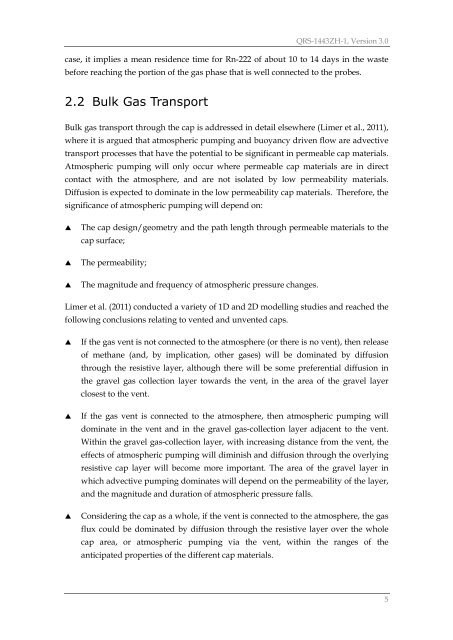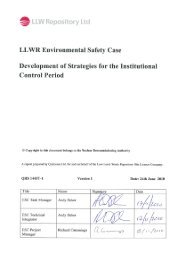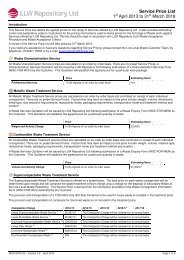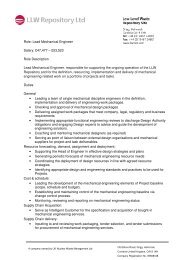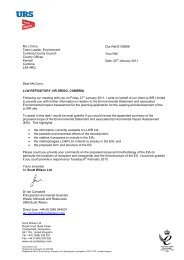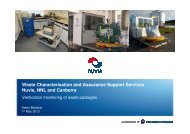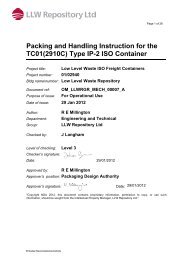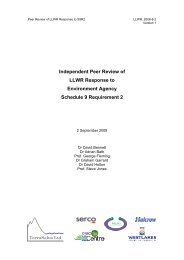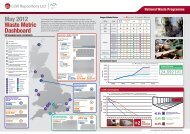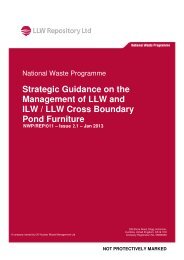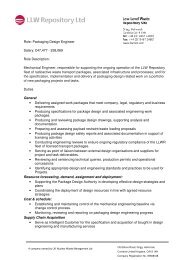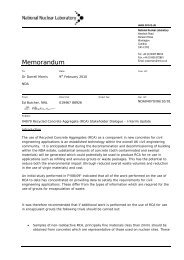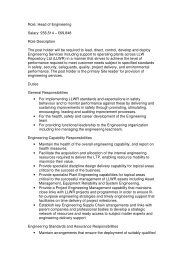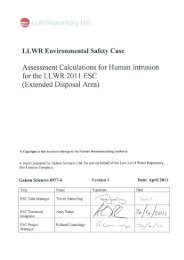Limer LMC, Assessment Calculations for C-14 Labelled Gas and ...
Limer LMC, Assessment Calculations for C-14 Labelled Gas and ...
Limer LMC, Assessment Calculations for C-14 Labelled Gas and ...
Create successful ePaper yourself
Turn your PDF publications into a flip-book with our unique Google optimized e-Paper software.
QRS-<strong>14</strong>43ZH-1, Version 3.0case, it implies a mean residence time <strong>for</strong> Rn-222 of about 10 to <strong>14</strong> days in the wastebe<strong>for</strong>e reaching the portion of the gas phase that is well connected to the probes.2.2 Bulk <strong>Gas</strong> TransportBulk gas transport through the cap is addressed in detail elsewhere (<strong>Limer</strong> et al., 2011),where it is argued that atmospheric pumping <strong>and</strong> buoyancy driven flow are advectivetransport processes that have the potential to be significant in permeable cap materials.Atmospheric pumping will only occur where permeable cap materials are in directcontact with the atmosphere, <strong>and</strong> are not isolated by low permeability materials.Diffusion is expected to dominate in the low permeability cap materials. There<strong>for</strong>e, thesignificance of atmospheric pumping will depend on:The cap design/geometry <strong>and</strong> the path length through permeable materials to thecap surface;The permeability;The magnitude <strong>and</strong> frequency of atmospheric pressure changes.<strong>Limer</strong> et al. (2011) conducted a variety of 1D <strong>and</strong> 2D modelling studies <strong>and</strong> reached thefollowing conclusions relating to vented <strong>and</strong> unvented caps.If the gas vent is not connected to the atmosphere (or there is no vent), then releaseof methane (<strong>and</strong>, by implication, other gases) will be dominated by diffusionthrough the resistive layer, although there will be some preferential diffusion inthe gravel gas collection layer towards the vent, in the area of the gravel layerclosest to the vent.If the gas vent is connected to the atmosphere, then atmospheric pumping willdominate in the vent <strong>and</strong> in the gravel gas-collection layer adjacent to the vent.Within the gravel gas-collection layer, with increasing distance from the vent, theeffects of atmospheric pumping will diminish <strong>and</strong> diffusion through the overlyingresistive cap layer will become more important. The area of the gravel layer inwhich advective pumping dominates will depend on the permeability of the layer,<strong>and</strong> the magnitude <strong>and</strong> duration of atmospheric pressure falls.Considering the cap as a whole, if the vent is connected to the atmosphere, the gasflux could be dominated by diffusion through the resistive layer over the wholecap area, or atmospheric pumping via the vent, within the ranges of theanticipated properties of the different cap materials.5


